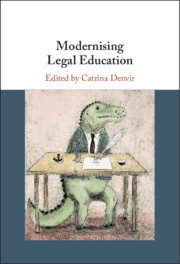Book contents
- Modernising Legal Education
- Modernising Legal Education
- Copyright page
- Contents
- Figures
- Tables
- About the Contributors
- Foreword
- Introduction
- 1 Do Lawyers Need to Learn to Code?
- 2 Experiential Legal Education
- 3 Skills Swap?
- 4 Scaling the Gap
- 5 Bringing ODR to the Legal Education Mainstream
- 6 Design Comes to the Law School
- 7 Developing ‘NextGen’ Lawyers through Project-Based Learning
- 8 Same As It Ever Was?
- 9 Ludic Legal Education from Cicero to Phoenix Wright
- 10 The Gamification of Written Problem Questions in Law
- 11 Virtually Teaching Ethics
- 12 Paths to Practice
- 13 ‘Complicitous and Contestatory’
- Afterword
- References
4 - Scaling the Gap
Legal Education and Data Literacy
Published online by Cambridge University Press: 30 December 2019
- Modernising Legal Education
- Modernising Legal Education
- Copyright page
- Contents
- Figures
- Tables
- About the Contributors
- Foreword
- Introduction
- 1 Do Lawyers Need to Learn to Code?
- 2 Experiential Legal Education
- 3 Skills Swap?
- 4 Scaling the Gap
- 5 Bringing ODR to the Legal Education Mainstream
- 6 Design Comes to the Law School
- 7 Developing ‘NextGen’ Lawyers through Project-Based Learning
- 8 Same As It Ever Was?
- 9 Ludic Legal Education from Cicero to Phoenix Wright
- 10 The Gamification of Written Problem Questions in Law
- 11 Virtually Teaching Ethics
- 12 Paths to Practice
- 13 ‘Complicitous and Contestatory’
- Afterword
- References
Summary
Over the last decade Artificial Intelligence (AI) in the form of data-driven tools designed to support legal task completion, have occupied a growing position within the delivery of private legal services and the exercise of administrative functions by the public sector. As a result, whilst technological literacy was once understood as the capacity to use particular forms of word processing software, navigate the Internet or send electronic correspondence, modern forms of literacy demand a user exhibits a broader range of skills, including the ability to understand, apply, visualise and infer patterns from data. This chapter considers the range of current initiatives developed to address the technology skills and awareness gap amongst law students, and identifies the subject areas that ought to take priority in future curriculum development. It argues that exposure to data analysis and data-driven technologies represents a necessary component of students’ preparation for entry into the professions on the basis that this knowledge: (i) enhances student employability in an increasingly competitive graduate job market; and (ii) equips graduates to meet their wider civic responsibilities to uphold the rule of law and promote access to justice.
Keywords
- Type
- Chapter
- Information
- Modernising Legal Education , pp. 73 - 91Publisher: Cambridge University PressPrint publication year: 2020
References
- 1
- Cited by



